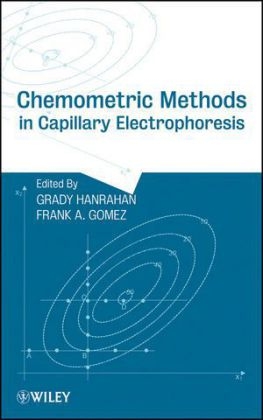
Chemometric Methods in Capillary Electrophoresis
John Wiley & Sons Inc (Verlag)
978-0-470-39329-1 (ISBN)
- Titel z.Zt. nicht lieferbar
- Versandkostenfrei innerhalb Deutschlands
- Auch auf Rechnung
- Verfügbarkeit in der Filiale vor Ort prüfen
- Artikel merken
Use chemometric techniques to develop optimum separation conditions for capillary electrophoreses For all its advantages, capillary electrophoresis (CE) also carries significant disadvantages for the researcher. Offering a unique blend of information from authors active in a variety of developments of chemometrics in CE, Chemometric Methods in Capillary Electrophoresis presents modern chemometric methods as an alternative to help alleviate the problems commonly encountered during routine analysis and method development.
Focusing on current chemometric methods utilized in CE endeavours by research-active experts in the field, the book begins with a thorough introduction to CE and chemometric-related concepts and the need for modern chemometric methods in CE.
Part 1 discusses differing types of screening designs and response surface methodology¿in an¿application based format
Part 2 includes vital discussion on various exploratory data analysis, prediction, and classification techniques utilized in CE-related studies
Part 3 provides practical information on modelling quantitative structure relationships
Part 4 explores transformation techniques, in particular fundamental studies and applications of cross-correlation and Hadamard Transform Electrophoresis
Showing how chemometric methods are applied in a wide array of applications including biological, medical, pharmaceutical, food, forensic, and environmental science, Chemometric Methods in Capillary Electrophoresis is not only highly significant to capillary electrophoresis-based endeavours, but instructive for investigators active in other areas of separation science who could benefit from its informative content.
Grady Hanrahan, PhD, received his doctorate in environmental analytical chemistry from the University of Plymouth, England. Dr. Hanrahan is currently the John Stauffer Endowed Professor of Analytical Chemistry at California Lutheran University with research interests in the use of modern chemometric methods in the design and development of environmental and bioanalytical instrumentation. He is also exploring the use of neural and evolutionary computational techniques for solving complex chemical problems. Frank A. Gomez, PhD, received his BS in chemistry from California State University, Los Angeles (CSULA), and his PhD in chemistry from UCLA, where he was a NIH Predoctoral Fellow. From 1991–1994, he was a Damon Runyon-Walter Winchell Cancer Research Fund Postdoctoral Fellow in the department of chemistry at Harvard University. He is a professor of chemistry at CSULA and is a visiting associate at Caltech in the Applied Physics department.
PREFACE. ACKNOWLEDGMENTS.
EDITOR BIOGRAPHIES.
CONTRIBUTORS.
KEY ACRONYMS.
I EXPERIMENTAL DESIGN AND OPTIMIZATION CONSIDERATIONS.
1 INTRODUCTION (Grady Hanrahan and Frank A. Gomez).
2 EXPERIMENTAL DESIGN IN METHOD OPTIMIZATION AND ROBUSTNESS TESTING (Bieke Dejaegher, Alexandra Durand, and Yvan Vander Heyden).
3 CHEMOMETRICAL EXPERIMENTAL DESIGN-BASED OPTIMIZATION STUDIES IN CAPILLARY ELECTROPHORESIS APPLICATIONS (Ruthy Montes, Toni Ann Riveros, Froseen Dahdouh, Grady Hanrahan, and Frank A. Gomez).
4 APPLICATION OF CHEMOMETRIC METHODS IN DRUG PURITY DETERMINATION BY CAPILLARY ELECTROPHORESIS (Gerhard K.E. Scriba).
5 OPTIMIZATION OF MICELLAR ELECTROKINETIC CHROMATOGRAPHY SEPARATION CONDITIONS BY CHEMOMETRIC METHODS (Jessica L. Felhofer and Carlos D. Garcia).
6 CHEMOMETRIC METHODS FOR THE OPTIMIZATION OF CE AND CE–MS IN PHARMACEUTICAL, ENVIRONMENTAL, AND FOOD ANALYSIS (Javier Hernández-Borges, Miguel Ángel Rodríguez-Delgado, and Alejandro Cifuentes).
7 OPTIMIZATION OF THE SEPARATION OF AMINO ACIDS BY CAPILLARY ELECTROPHORESIS USING ARTIFICIAL NEURAL NETWORKS (Amanda Van Gramberg, Alison Beavis Lucas Blanes, and Philip Doble).
II EXPLORATORY DATA ANALYSIS, PREDICTION, AND CLASSIFICATION.
8 DEVELOPMENT OF CAPILLARY ELECTROPHORESIS FINGERPRINTS AND MULTIVARIATE STATISTICS FOR THE DIFFERENTIATION OF OPIUM AND POPPY STRAW SAMPLES (Raymond G. Reid, Susanne P. Boyle, Ann S. Low, and David G. Durham).
9 MULTIVARIATE CURVE RESOLUTION BASED ON ALTERNATING LEAST SQUARES IN CAPILLARY ELECTROPHORESIS (Javier Saurina).
10 APPLICATION OF CHEMOMETRICS IN CAPILLARY ELECTROPHORESIS ANALYSIS OF HERBAL MEDICINES (Shao-Ping Li, Xiao-Jia Chen, and Feng-Qing Yang).
11 CLINICAL PATTERN RECOGNITION ANALYSIS APPLYING ARTIFICIAL NEURAL NETWORKS BASED ON PRINCIPAL COMPONENT ANALYSIS INPUT SELECTION (Yaxiong Zhang and Hua Li).
12 CHEMOMETRIC METHODS APPLIED TO GENETIC ANALYSES BY CAPILLARY ELECTROPHORESIS AND ELECTROPHORESIS MICROCHIP TECHNOLOGIES (Maribel Elizabeth Funes-Huacca, Juliana Vieira Alberice, Lucas Blanes, and Emanuel Carrilho).
13 EXPLORATORY DATA ANALYSIS AND CLASSIFICATION OF CAPILLARY ELECTROPHORETIC DATA (Melanie Dumarey, Bieke Dejaegher, Alexandra Durand, and Yvan Vander Heyden).
III QUANTITATIVE STRUCTURE RELATIONSHIPS.
14 CHEMOMETRICAL MODELING OF ELECTROPHORETIC MOBILITIES IN CAPILLARY ELECTROPHORESIS (Mehdi Jalali-Heravi).
15 ASSESSMENT OF SOLUTE–MICELLE INTERACTIONS IN ELECTROKINETIC CHROMATOGRAPHY USING QUANTITATIVE STRUCTURE–RETENTION RELATIONSHIPS (Edgar P. Moraes, Fernando G. Tonin, Luís G. Dias, João P.S. Farah, and Marina F.M. Tavares).
16 CHEMOMETRICAL ANALYSIS OF CHEESE PROTEOLYSIS PROFILES BY CAPILLARY ELECTROPHORESIS: PREDICTION OF RIPENING TIMES (Natividad Ortega, Silvia M. Albillos, and María D. Busto).
IV TRANSFORMATION TECHNIQUES.
17 TRANSFORMATION TECHNIQUES FOR CAPILLARY AND MICROCHIP ELECTROPHORESIS (Takashi Kaneta).
INDEX.
| Verlagsort | New York |
|---|---|
| Sprache | englisch |
| Maße | 161 x 241 mm |
| Gewicht | 748 g |
| Einbandart | gebunden |
| Themenwelt | Naturwissenschaften ► Chemie ► Analytische Chemie |
| ISBN-10 | 0-470-39329-7 / 0470393297 |
| ISBN-13 | 978-0-470-39329-1 / 9780470393291 |
| Zustand | Neuware |
| Haben Sie eine Frage zum Produkt? |
aus dem Bereich


